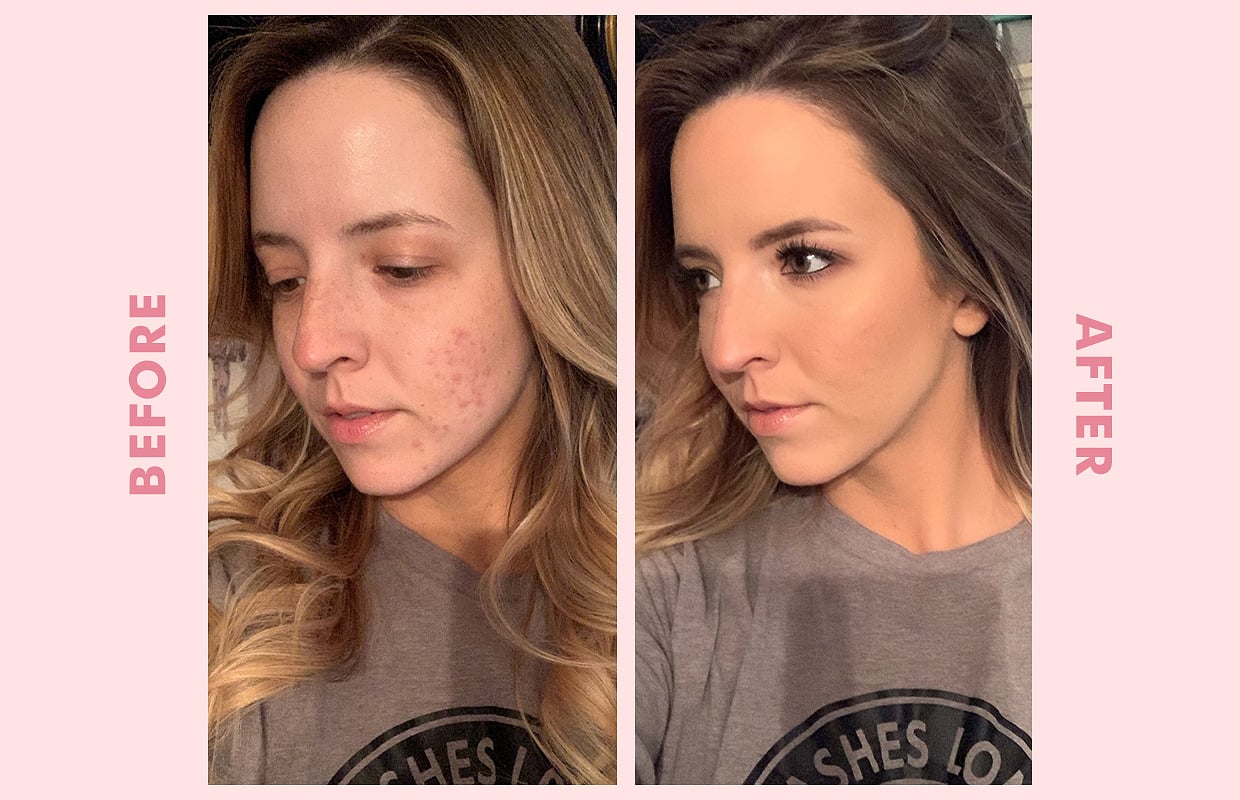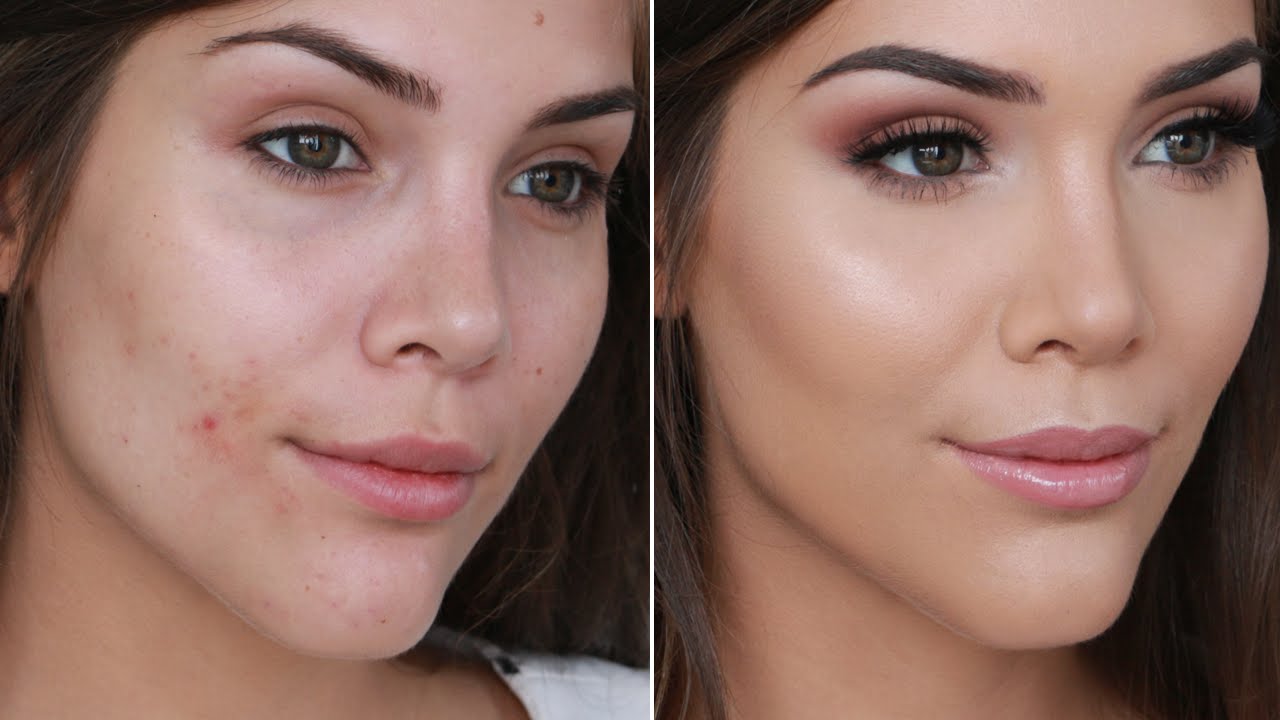To effectively cover acne with makeup, use a non-comedogenic primer followed by a full-coverage, oil-free foundation. Concealer that matches your skin tone can then be applied to individual blemishes.
Concealing acne with makeup can be a delicate process that boosts confidence and creates a flawless complexion. It requires the right products and techniques to ensure that the coverage looks natural and stays put throughout the day. Starting with a clean, moisturized face is essential, as it provides a smooth canvas for makeup application.
Choosing makeup that’s specifically formulated for acne-prone skin is crucial to prevent further breakouts. The objective is to achieve an even skin tone while being gentle to your skin, making sure the products blend seamlessly. With careful application and the correct tools, blemishes can be concealed, revealing your best face forward.
:max_bytes(150000):strip_icc()/184850775_3921279024633864_8758604106964186855_n-227e05b8bd0242f39cb4b26e4ca458fe.jpg)
Credit: www.byrdie.com
Introduction To Acne Coverage
Dealing with acne can be a tough battle, not just for your skin but for your confidence too. Finding the right way to cover acne with makeup can transform your appearance and boost your self-esteem. This section of the blog dives into the art of concealing blemishes with makeup. Learn to master acne coverage and present your best face forward every day.
The Challenge Of Hiding Blemishes
Acne is unpredictable and varies in size, color, and texture. Covering different types of blemishes requires skill and the right products. Redness, swelling, and uneven skin surface are just a few issues to tackle. Our tips will help you face these challenges to achieve a smoother, more even complexion.
Goals Of Acne-concealing Makeup
- Even Out Skin Tone: Create a uniform color across your face.
- Reduce Redness: Calm the appearance of inflamed areas.
- Smooth Texture: Minimize the look of raised or depressed acne.
- Long-Lasting Wear: Ensure makeup stays put without caking or fading.
- Non-Irritating: Use products that won’t aggravate your skin.
Prepping Your Skin
Before diving into the art of covering acne with makeup, it’s vital to prepare your skin. Proper skin preparation can make a huge difference. It helps your makeup apply smoothly and last longer. Let’s explore the best ways to get your skin ready for a flawless makeup application.
Cleansing And Moisturizing
Starting with a clean canvas is key. Use a gentle cleanser to remove dirt and oil without irritating your acne. Pat your skin dry with a soft towel. Next, apply a lightweight moisturizer. Wait a few minutes for it to absorb. This step helps protect your skin and keeps makeup from clinging to dry patches.
- Choose a cleanser that suits your skin type.
- Pat your skin dry to avoid irritation.
- Moisturize to create a smooth base for makeup.
Primer Application For A Smooth Canvas
Primer is a game-changer for acne-prone skin. It fills in pores and fine lines, creating a smooth surface. Look for a primer that addresses your specific skin concerns. Apply a small amount and blend it evenly. This creates the perfect base for concealer and foundation.
| Step | Action |
|---|---|
| Select a primer | Match it with your skin type |
| Apply primer | Use a pea-sized amount |
| Blend evenly | Focus on areas with acne |
With your skin now prepped, you’re ready to move on to concealing and setting your makeup for a look that’s both beautiful and acne-friendly.
Choosing The Right Products
Having acne can feel like a battle, both with your skin and with finding makeup that helps rather than hinders. The secret lies in choosing the right products. Your makeup routine can transform the way your skin looks and feels. Start with these essential steps to cover acne effectively.
Selecting The Perfect Concealer
Concealers are the first line of defense in covering acne. Look for non-comedogenic formulas that won’t clog pores. A green-tinted concealer neutralizes redness, while a thick, creamy texture provides better coverage. Make sure it matches your skin tone.
- Test shades on your jawline, not your hand.
- Choose a concealer with salicylic acid to help heal blemishes.
- Consider a color-correcting palette for different types of discoloration.
Foundation Types For Acne-prone Skin
Foundations for acne-prone skin should be lightweight and oil-free. This helps prevent further breakouts. There are several types to consider:
| Type | Benefits | Best For |
|---|---|---|
| Liquid | Easy to apply, blendable | Most skin types |
| Powder | Light coverage, mattifying | Oily skin |
| Mousse | Lightweight, airbrush finish | Combination skin |
| Mineral | Natural ingredients, non-irritating | Sensitive skin |
| Stick | Full coverage, precision application | Targeted areas |
Remember to patch test any new product before applying it to your entire face. Your skin’s reaction is vital in determining the right match for you.
Color Correction Techniques
Embarking on the journey to flawless makeup over acne can be daunting. Color correction techniques stand as a beacon of hope. They transform your canvas, ensuring a more even and natural look. Mastering these techniques is a game-changer for anyone looking to conceal imperfections seamlessly.
Understanding Color Theory
To conquer color correction, grasp the basics of color theory. It’s the cornerstone of this makeup technique. Simply put, colors opposite each other on the color wheel cancel each other out. This principle is your secret weapon for neutralizing acne’s appearance.
Neutralizing Redness With Green-tinted Products
Acne often brings unwanted redness. Green-tinted products are your ally here. They directly oppose red on the color wheel. A light dab of green concealer on red spots can work wonders. Follow with a skin-toned product for a natural finish. Here’s how to do it:
- Cleanse and moisturize your skin first.
- Apply a primer to create a smooth base.
- Use a green concealer to dab on red areas.
- Blend well with a makeup sponge or brush.
- Top off with your regular foundation or concealer.
- Set the makeup with a translucent powder.
Application Methods For Concealing
Mastering the art of concealing acne with makeup is a game-changer for anyone looking to achieve a flawless complexion. Proper application methods are key to creating a look that not only covers blemishes but also appears natural. Let’s dive into the techniques that will help you layer and blend products like a pro.
Layering Products Effectively
Start with a clean, moisturized face to ensure a smooth canvas. A primer can be your best friend, providing an even base for the rest of your makeup. Begin with a light layer of foundation that matches your skin tone. Use a concealer specifically designed for acne; these often contain salicylic acid that helps treat while concealing. Apply with a fine brush to pinpoint blemishes.
Here’s a step-by-step guide to layering:
- Apply primer to smooth the skin.
- Use a foundation brush for the first foundation layer.
- Dot concealer on blemishes and gently tap with a clean fingertip or sponge.
- Set with a loose powder to lock the base in place.
- If needed, add another thin layer of concealer and powder.
Blending For A Natural Look
Blending is essential for a seamless finish. Use a damp sponge or beauty blender for this step. Lightly dab over the areas where you’ve applied concealer to meld the product into the foundation. Avoid rubbing or dragging, as this can remove product and irritate acne-prone skin. Focus on the edges of the concealed areas to ensure there are no visible lines.
Remember these blending tips:
- Use a patting motion with a sponge to blend.
- Blend the edges for a smooth transition.
- Keep a light hand to avoid wiping away coverage.
Setting Your Makeup
After concealing acne, the next crucial step is setting your makeup. Proper setting ensures your look remains flawless all day. It prevents makeup from sliding off or caking up on acne-prone areas. Let’s explore how to choose the right setting powders and share some tips for long-lasting makeup.
Choosing Setting Powders
Setting powders lock in your base and reduce shine. For acne-prone skin, non-comedogenic and oil-absorbing powders work best. They should be lightweight to avoid heavy buildup. Here are some pointers:
- Opt for mineral-based powders that offer coverage without clogging pores.
- Translucent powders are great for a natural look.
- Colored powders should match your skin tone closely to avoid highlighting blemishes.
Long-lasting Makeup Tips
To keep your makeup fresh and in place, consider these strategies:
- Use a primer before applying foundation to create a smooth canvas.
- Layer products wisely—start with less and build up as needed.
- Blot excess oil throughout the day with oil-absorbing sheets.
- Refresh with a setting spray to hydrate skin and revive makeup.
- Avoid touching your face to reduce smudging and bacteria transfer.
Enhancing Your Look
Welcome to the ‘Enhancing Your Look’ section of our blog, where we dive into the art of using makeup to cover acne effectively. A flawless finish is not just about hiding blemishes; it’s about strategically drawing attention to your best features. Let’s explore how you can use makeup to not just cover acne, but to enhance your overall appearance.
Focusing On Other Features
Distract from acne by highlighting your best features. Whether it’s your eyes or lips, choose one to enhance.
- Bold eye makeup draws attention upwards. Try a vibrant eyeshadow or a dramatic eyeliner.
- Luscious lip colors keep the focus on your smile. Select a shade that complements your skin tone.
- Define your eyebrows. Well-groomed brows frame your face and enhance your eyes.
Using Highlight And Contour To Your Advantage
Highlight and contour can reshape your face. They create shadows and highlights that draw the eye away from blemishes.
- Apply highlighter on the high points of your face, like cheekbones and the bridge of the nose, to bring forward these areas.
- Use contour shades to add depth under cheekbones and along the jawline.
- Blend well to avoid harsh lines. Soft blending makes the look natural and subtle.
Maintaining Acne-friendly Makeup Habits
When it comes to acne, makeup can be both a cover-up and a cause. A smart makeup routine can help you hide blemishes without making acne worse. Let’s explore some essential habits to keep your makeup acne-friendly and your skin happy.
Regular Cleaning Of Makeup Tools
Dirty brushes and sponges can spread bacteria and worsen acne. Clean tools mean clear skin. Follow these steps for pristine makeup tools:
- Wash brushes once a week with a gentle cleanser.
- Rinse sponges after each use and microwave them damp for a minute to kill bacteria.
- Air-dry tools completely before next use to prevent mold.
Choosing Non-comedogenic Products
Non-comedogenic makeup won’t clog pores. This is crucial for acne-prone skin. Always check labels before buying. Here’s what to look for:
| Product Type | What to Seek | What to Avoid |
|---|---|---|
| Foundations | Oil-free, non-acnegenic | Heavy, greasy formulas |
| Concealers | Salicylic acid-based | Thick, creamy textures |
| Powders | Mineral-based | Talc-heavy, pore-clogging |
Remember, the right habits can transform your makeup routine into an acne-fighting ally. Keep those tools clean and choose your products wisely!
Dealing With Makeup And Acne Throughout The Day
When you have acne, managing your makeup through the day can be tricky. Keeping your skin looking fresh and clear from morning to night is essential. Let’s explore some pro tips to maintain a flawless appearance.
Touch-up Strategies
Be prepared for quick fixes to keep your makeup intact. A compact powder or blotting papers are lifesavers. They absorb excess oil without smudging your makeup. Carry a mini concealer for sudden blemishes. Use a light dabbing motion to apply, blending it seamlessly.
- Blotting papers: Gently press onto oily areas to remove shine.
- Compact powder: Apply a thin layer to control shine without caking.
- Mini concealer: Touch up any blemishes as they appear.
Managing Oil And Shine
For those with oily skin, shine can be a constant battle. Use products designed for oil control. Mattifying primers and oil-free foundations work best. A setting spray can lock your look in place. Remember to choose non-comedogenic products to avoid clogging pores.
| Product Type | Use |
|---|---|
| Mattifying Primer | Apply before foundation for oil control. |
| Oil-Free Foundation | Use as base to reduce shine. |
| Setting Spray | Spritz to set makeup and control oil. |
Regular check-ins with a mirror can help. When you notice shine, take a moment to blot and powder. This maintains a matte finish and prevents makeup from sliding off.

Credit: blog.reneerouleau.com
Conclusion: Embracing Your Skin
Mastering the art of covering acne with makeup is a valuable skill. Yet, the true beauty lies in embracing your skin, imperfections and all. This acceptance builds confidence and promotes a healthier relationship with your self-image. Remember, makeup is a tool to enhance, not to hide who you truly are.
Confidence Beyond The Makeup
Confidence shines brighter than any foundation or concealer. It comes from within and radiates outward. When you accept your skin, the need for a perfect makeup day becomes less crucial. This self-assurance is your most beautiful feature. It’s not about the makeup; it’s about how you carry yourself with or without it.
Healthy Skin Routine Reminders
Alongside embracing your skin, maintaining a healthy skin routine is essential. Here are key reminders:
- Stay consistent with your skincare regimen.
- Gentle cleansing keeps skin clear and reduces acne.
- Hydration is vital; drink water and moisturize daily.
- Nourish your body with healthy foods for better skin.
- Sleep well to allow your skin to repair overnight.
Remember, these steps are as crucial as any makeup technique. They ensure your skin stays healthy and vibrant, providing the perfect canvas for any look you wish to create.

Credit: m.youtube.com
Frequently Asked Questions
How To Cover Your Pimples With Makeup?
Start by cleansing your skin and applying a primer. Use a green concealer to neutralize redness. Dab on a matching shade of foundation. Set with a light dusting of translucent powder. Blend carefully for a natural finish.
How Do You Make Makeup Look Good With Acne?
Start by gently cleansing and moisturizing your skin. Use non-comedogenic makeup to prevent pore-clogging. Apply a green-tinted primer to neutralize redness. Choose oil-free foundation and concealer to cover blemishes, blending well. Set your look with a light, translucent powder to minimize shine.
Is Foundation Or Concealer Better To Cover Pimples?
Concealer is better for targeted coverage on pimples, while foundation provides overall skin tone evening. Use concealer directly on blemishes for optimal concealment.
What Is The Best Foundation For Acne Coverage?
The best foundation for acne coverage is non-comedogenic, oil-free, and contains salicylic acid to help treat breakouts. Choose a formula that offers buildable coverage to effectively conceal blemishes without clogging pores.
Conclusion
Concealing acne with makeup doesn’t have to be a struggle. With the right techniques and products, you can achieve a flawless look. Remember to choose non-comedogenic items to avoid clogging pores. Practice makes perfect, so keep experimenting until you master the art of camouflaging blemishes.
Now, step out with confidence and let your beauty shine!

